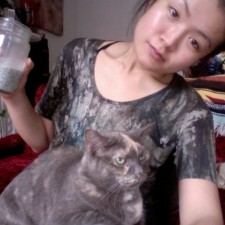Joanna Cheung (張祖恩) is a transdisciplinary artist and designer.
Cheung creates physical and virtual spaces, which produce experiences breaking down the hierarchical balance between architecture and occupants. Cheung creates objects which subvert our understanding of our interaction and relation to the object.
Her creative practice is driven by ideas of transgenerational trauma, feminism, & phenomenological reactions, mediated through tools such as rapid prototyping, open-source hardware/software, and the internet.
Cheung holds a Masters of Fine Arts from University of California, Los Angeles, and a Bachelor of Architecture from Pratt Institute.
Eyebeam Project Resident (2015):
Historicity (2015)
Soft/hardware, acrylic, TFT
LCD, speakers, pull switch
36″ x 36″ x 18″
Historicity is the preservation and analysis of
Cheung’s close relationships, transcribed into digital language/code. Documenting these interactions with family friends is an existential exercise. Different relationships are transcribed as functions( ). Each cone is one relationship.
This project was featured in a group exhibition for the 2015 Project Residents titled, “Inside/Out”
About Eyebeam Exhibition: Inside/Out (2015)
Featured Artists:
Kenneth Kirschner and Joshue Ott, Joanna Cheung, Tega Brain, Lilian Kreutzberger, and Collaborators Gene Kogan and Lisa Kori.
Lines don’t just separate; they’re also a meeting place, where surfaces are joined. This exhibition highlights five projects made during the 2015 Eyebeam project residencies, which probe at the porous boundary between the external and the internal, by examining how technologies make visible, audible or thinkable that which is normally hidden away inside.
A subtly interactive installation by Kirschner and Ott allows visitors’ gestures to take on a material form in light and sound. Cheung’s dialogues with her family inventively adapt computer code for its storytelling power. Using natural elements, Brain creates sensory experiences from the wi-fi networks which surround us. Kreutzberger’s paintings interrogate and layer invisible connectivities, while Kogan and Kori explore tools for digital performativity—and in particular, opera.
These works were examples of technology in an expanded sense: they are physical and conceptual tools by which we navigate and ultimately transform our contexts. This show was preceded by the exhibition Outside/In, which sought to bring digital imagery into dialogue with physical architecture.
